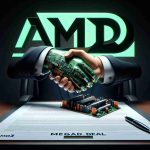An Artist’s Unique Vision
Bernard Muller showcases a captivating exploration of artistic expression through the innovative use of technology. Embracing the concept of harnessing artificial intelligence, Muller’s creative process transcends limitations to produce colorful and imaginative artworks. Rather than focusing on traditional mediums, Muller’s approach involves a collaborative dance between himself and AI, utilizing eye-tracking technology to communicate and create.
Infusing Personal Journey into Art
Muller’s journey, marked by the announcement of his diagnosis with amyotrophic lateral sclerosis (ALS) in 2010, serves as a profound influence on his art. Each piece crafted is not merely an artistic expression but a reflection of personal experiences and challenges faced. Through art, Muller finds a powerful outlet to convey emotions and thoughts that might otherwise be difficult to articulate. His resilience in the face of adversity echoes a deeper connection between artistic creation and personal growth.
AI as the Modern Brush
In Muller’s artistic realm, artificial intelligence emerges as a transformative tool, akin to a modern-day brush. By leveraging AI algorithms and eye-tracking technology, Muller breathes life into his visions, transcending physical limitations to explore a myriad of artistic styles and concepts. The infinite possibilities offered by AI fuel Muller’s creativity, enabling him to experiment with textures and styles that might have been challenging through traditional means.
Empowering Creative Expression
Through Muller’s unique blend of technology and creativity, he reshapes the landscape of artistic expression. The dynamic and innovative process he employs results in mesmerizing and emotionally resonant artwork, encapsulating the essence of his journey. Muller’s participation in initiatives like #HONORtheChallenger not only raises awareness about ALS but also celebrates the resilience and determination of individuals facing adversity.
Embracing a New Chapter in Art
Bernard Muller’s artistic evolution stands as a testament to the transformative power of technology in shaping creative endeavors. His journey exemplifies the fusion of artistry and innovation, sparking a new chapter where boundaries are transcended, and artistic visions find boundless expression.
Pushing Boundaries: Advancing Artistic Expression Through Technology
Bernard Muller’s exploration of artistic expression through technology highlights the captivating intersection of creativity and innovation. As we delve deeper into this realm, new facets emerge, raising essential questions and considerations about the impact and future of technology in art.
Key Questions:
1. How does the use of technology in art influence the traditional artist-audience relationship?
2. What ethical considerations arise when artificial intelligence plays a significant role in artistic creation?
3. How can artists navigate the balance between personal expression and technological influence in their works?
Challenges and Controversies:
One of the key challenges associated with exploring artistic expression through technology is the potential homogenization of art. As more artists turn to AI and other advanced tools, concerns about originality and authenticity surface. Additionally, the ethical implications of using AI in art raise questions about authorship, ownership, and the role of the artist in the creative process.
Advantages and Disadvantages:
Advantages:
– Technology allows artists to push their creative boundaries and explore new possibilities that may not have been achievable through traditional methods.
– Accessibility and democratization of art increase as technology enables artists to reach wider audiences and engage with diverse communities.
– Collaborative efforts between artists and AI can lead to innovative and thought-provoking creations that challenge conventional artistic norms.
Disadvantages:
– The dependency on technology could potentially diminish the tactile and intuitive aspects of creating art, affecting the artist’s connection to their work.
– Issues of privacy and data security may arise when using AI algorithms and eye-tracking technology, especially in relation to personal or sensitive artistic content.
– The divide between technologically advanced artists and those who prefer traditional methods may widen, leading to disparities in opportunities and recognition within the art world.
In exploring the fusion of art and technology, it is essential to acknowledge the multifaceted landscape it presents, encompassing both exciting possibilities and complex challenges. As artists like Bernard Muller pave the way for this new artistic frontier, bridging the gap between human creativity and technological innovation, the future of artistic expression holds a myriad of untapped potentials and compelling journeys.
For more insights into the evolving relationship between art and technology, visit ArtNews.


















